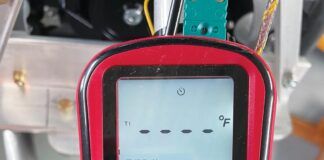In todays modern Experimental aircraft, the question isn’t whether to have GPS (global positioning system) navigation but, instead, which particular box (or boxes) to buy. Its become practically as important as the engine and wings. With incredible accuracy and, so far, excellent reliability, GPS navigators have outstripped all the familiar navigation echnologies.
While there are myriad ways to divide up the GPS universe, one always works: capability. And here it comes down to a simple dichotomy: Can the GPS be certified for IFR use or not? This month we look at those GPSes that cannot, the socalled VFR boxes that, while fully featured and capable, are just not destined for a life of (legally) leading you through the clouds. Next month, well get into the details of IFR-approved navigators and help you determine what makes a safe and legal installation.
Recently, there is a trend in the handheld and portable GPS market to go with bigger, brighter and more detailed screens. Sizes of the units have grown to the point where a number of them are actually tablet PCs with large screens. The upside to these units is the amazing amount of detail and information that can be displayed on a screen. Functionality such as satellite weather, IFR and/ or VFR charts, fl ight planning and more are now becoming much more common on some portable GPS units. While still in the category of being portable, some of these units require external battery power and a leg strap or alternative mounting method.
Another popular use for traditional handhelds is to mount them semi-permanently into the aircraft panel. Made popular by a company called AirGizmos (created by RV builder Mike Schipper), these nift y docks allow a builder to mount many of the popular portable GPSes into the instrument panel or radio stack, and still remove them for convenience.
With the freedom aff orded by the AirGizmos mounts-and, for that matter, by custom attachment schemes that we see every year on the flight lines in Lakeland and Oshkosh-literally building a portable GPS into the airplane has become popular and useful. With that in mind, lets look at the portable options that we’ve had experience with here at the shop, discounting for the moment the ever-changing world of soft ware products to turn laptops and PDA (personal digital assistant) devices into moving maps.
Buon Giorno, Piloti
EKP-IV. Th e Italian AvMap currently offers the largest screen purpose-built portable GPS on the market. With a 7- inch diagonal screen, the EKP-IV provides a ton of information including terrain awareness, obstacle database, full city/street road data, aeronautical information and the capability to interface with either TruTrak or Trio autopilots. The AvMap is unique in that the user can display the information (also in split screens) either vertically or horizontally, which offers some flexibility when mounting with an Air- Gizmo panel dock. Currently, the EKPIV is not available with weather, but we expect that in the future AvMap will most likely provide this functionality.
Price: $1499.
Geopilot
. AvMap recently introduced this GPS as a lower cost and somewhat more compact option. Its not quite as large as the EKP, but with a 5.6-inch screen is still much larger than some of the competitors units. Th is model is relatively new, so we don’t have much experience with it, but it appears to be a nice unit for the price.Price: $999.
Pros
: Price point and size make the EKP-IV and Geopilot good buys. The screens are easy to read, and the buttons and menu structure are easy to understand.Cons: The large size makes them difficult to panel-mount in some aircraft, and they can be a bit clumsy in the cockpit. No satellite weather at this time, and in the past communication with autopilots was finicky.
Bendix/King Plays with Portables
Price: $2750.
Pros
: Probably the easiest screen to read and easiest navigation menu structure weve seen.Cons
: High price, no battery or WAAS.Garmin Portables: Bread, Meet Butter
GPSMAP 96/96C
. Th e entry-level GPSMAP 96 duo (the C is a color version) is the latest in a long line of vertical-format handhelds that truly put Garmin on the map. (Those of us who remember the GPS 89/90/92 series will recall what a splash these svelte GPSes made when they were introduced. No one figured you could get so much stuff into such a small container.) While the 96s screen is only 2.2 inches across, this unit packs a full Jeppesen database as well as the capability to be used as a street or marine navigator, off ering the user a lot of bang for the buck. It nominally uses AA batteries but can be hooked to ships power and will output a serial data stream for a connection to autopilots and EFISes.Prices: $399 monochrome; $599 color.
GPSMAP 196/296
. Th e grayscale 196 was one of the fi rst aviation GPSes to offer a basic synthetic panel view of instruments on its 3-inch display. With a panel dock, this unit can easily be mounted in your aircraft . The similarly packaged 296 adds a bright 256-color screen with built-in terrain data. The bright and vivid colors of the display make the terrain and obstacle information extremely useful in the cockpit. Both of these units represent a tremendous value for the price, and both will interface nicely with TruTrak and Trio autopilots. Th ey are strong performers if you don’t want or need the onboard weather offered by the next two Garmins.Prices: 196, $799; 296, $1495.
GPSMAP 396/496
. When Garmin introduced the 396 GPS a few years ago, the amount of functionality packed into this box amazed a lot of people. Expanding on the color 296 (and packaged in a similar box), Garmin found a way to shoehorn a lot of neat new features into this little package. First, the XM satellite weather brings an unparalleled amount of data to the pilot. Now, instead of relying on hours-old information, pilots can have relatively current pictures of the weather situation for their entire fl ight! With the satellite weather comes satellite music. Of course you’ll need to buy a subscription, but there are varying features at different price points. The GPS 496 yet again expands on this popular line of GPSes by adding a faster processor, into such a small container.) While the 96s screen is only 2.2 inches across, this unit packs a full Jeppesen database as well as the capability to be used as a street or marine navigator, offering the user a lot of bang for the buck. It nominally uses AA batteries but can be hooked to ships power and will output a serial data stream for a connection to autopilots and EFISes.Prices: $399 monochrome; $599 color.
GPSMAP 196/296
. The grayscale 196 was one of the fi rst aviation GPSes to offer a basic synthetic panel view of instruments on its 3-inch display. With a panel dock, this unit can easily be mounted in your aircraft . The similarly packaged 296 adds a bright 256-color screen with built-in terrain data. The bright and vivid colors of the display make the terrain and obstacle information extremely useful in the cockpit. Both of these units represent a tremendous value for the price, and both will interface nicely with TruTrak and Trio autopilots. They are strong performers if you don’t want or need the onboard weather offered by the next two Garmins.Prices: 196, $799; 296, $1495.
GPSMAP 396/496
. When Garmin introduced the 396 GPS a few years ago, the amount of functionality packed into this box amazed a lot of people. Expanding on the color 296 (and packaged in a similar box), Garmin found a way to shoehorn a lot of neat new features into this little package. First, the XM satellite weather brings an unparalleled amount of data to the pilot. Now, instead of relying on hours-old information, pilots can have relatively current pictures of the weather situation for their entire flight! With the satellite weather comes satellite music. Of course you’ll need to buy a subscription, but there are varying features at different price points. The GPS 496 yet again expands on this popular line of GPSes by adding a faster processor, more memory, newer softwaare and a hostg of additional features such as a full AOPA Airport Directory and Garmin’s SafeTaxi data which provides taxiway diagrams and positional information for a numb er of mid- to larger-size airports.Prices: 396, $2195; 496, $2795.
Pros: First of the larger screen portables, the display is crisp and sharp.All of the Garmin units pack a ton of usable functionality into a small package. The color 396/496 with XM weather is truly a phenomenal addition to your panel.
Cons: The grayscale 196 can sometimes be hard to read in bright sunlight. The price point of the higher-end units puts them out of reach for some pilots.
From the Fishfinder Folks
Lowrance has been making aviation products for a while now, and it’s a stalwart in the marine business. Its newest products are pretty slick and offer a lot of bang for the buck, even if they must, by necessity, play second fiddle to theGarmin machines.
AirMap 1000/2000C
. The 5-inchdiagonal large-screen AirMap 1000 and 2000C (color) GPSes pack a lot of features into a nice size bundle. The Air-Map 1000 is black and white, and offers the expected aviation database as well as obstacles and street references. The Air-Map 2000C is a brightly colored display that also adds terrain awareness. With both of these products, Lowrance has created unique screen layouts that give an almost EFIS look, with airspeed and altitude tapes along the sides of the screen. Both units have a cursor pad and some dedicated buttons, but the menu structure and navigation can sometimes be aggravating compared to the Garmin units-not necessarily bad, but not quite as slick and simple as the best Garmin has to offer. We’ve found that the interface and output to TruTrak and Trio autopilots work well. Overall, the Air-Map 2000C is a strong contender in the market, and though not quite as featurepacked as some competitors units, they still are a decent unit at a decent price.Prices: 1000, $599; 2000C, $999.
Pros
: Nice large screen, integral battery and low price.Cons: Screen resolution appears somewhat lower than competitors, and menu structure for inputs can require multiple button pushes, which is somewhat aggravating.
AirMap 600C
. Th e new AirMap 600C is a color aviation GPS complete with terrain. The screen isn’t huge, but at nearly 3 inches diagonally, its enough to see what you need. One really nifty aspect of this GPS is a screen that shows the aircraft and its vertical fl ight path relative to terrain. Lowrance also added its own version of taxiway data into this GPS. Overall, this unit packs a lot of utility into a small unit.Price: $499.
Pros
: Price points coupled with functionality make for a good value.Cons
: Not as many features as the competitors have. Screen size is small for the amount of data displayed.Lets Talk Panel-Mounts
KLN35A. Bendix/King s VFR panelmount GPS is a derivative of the KLX135A, which debuted fi rst. The basic monochrome moving map gives relatively little detail compared to even a basic portable, but it has a simple, robust operating system and easy-to-learn menu logic going for it. Otherwise, there’s not a lot to recommend here, and it shows in our sales numbers. We rarely see them and haven’t installed one of these stand-alone GPSes in over three years.
Price: $2000.
Pros
: One of the lowest price panel-mount GPSes available.Cons
: Outdated, not cheap. KLX135A. When this GPS/com box was introduced more han 10 years a o, it was truly innovative. It was among the first to adopt a moving-map GPS integrated with a com transceiver in a single box. The screen is bright but with low resolution. The integrated GPS database in the box will automatically load frequencies for selection by the pilot into the transceiver. With the current selection of competing avionics, this box has frankly just become outdated. Our opinion is your money would be better spent buying a good com transceiver and one of the higher-end handheld GPSes.Price: $3500.
Pros
: The combination of both a GPS and a com transceiver in one box is handy.Cons
: Doesnt offer a lot of capability compared to just buying a handheld and stand-alone com radio.KMD150/250
. The 5-inch, largescreen KMD150 is an excellent VFR moving map and GPS. Similar to the Skymap portable, we really like this map from a usability and viewing standpoint. What we don’t like is the $4000+ price tag. Th e KMD250 is a smaller unit (3.8-inch display) intended for integration with other units such as weather, terrain/ TAWS, radar and GPSes like the King KLN series. As a stand-alone GPS its VFR-only without much functionality compared to the competition. Not worth the price as a stand-alone GPS in our opinion.Price: $4500.
Pros
: Time-tested and well-proven reliability. Easy-to-read screen and user-friendly navigation.Cons
: No new updates from King in years, and the company seems ambivalent about homebuilders.VFR Boxes from Garmin
GPS 150XL
. From a general standpoint, this unit from Garmin is comparable to the KLN35A from Bendix/King-with a few major benefi ts. Th e menu structure is easier to use, the knobs are large with strong detents. Th e map is somewhat larger than the 35As and because of a higher resolution is easier to read. Its still expensive for a stand-alone VFR GPS (especially when compared to Garmins higher-end handhelds), but as a panel-mount, entry-level GPS its a pretty nice box.Price: $3100.
GNC 250XL
. Expanding on the functionality of the GPS 150XLs moving map, this box adds a 760-channel, 5-watt com transceiver. This is a decent VFR GPS/com unit that mounts cleanly in a standard radio stack.Price: $2995.
Pros
: Easy-to-read bright screen, buttons are high quality, and menu system is fairly intuitive.Cons
: Low in functionality compared to Garmins own handhelds.Internal Matters
A dizzying array of GPSes is available for installation in our homebuilts- from basic handheld/portable units and VFR panel-mounts to high-end IFR units. Most of them will communicate nicely with autopilots, which adds one more level of safety to your flying. Overall, at the moment, Garmin and Lowrance seem to have a clear lead in the portable market. But Oshkosh AirVenture is right around the corner- just starting as you read this-and its a sure bet well see something there that knocks our socks off .
Next time well dive into the legalities of using an approved GPS for IFR fl ight-specifically, well look at the boxes and the installation issues to keep in mind. Its a category of navigator thats slightly less clear than it could be, but well help you get to the bottom of it.
_____________________________________________________________________
If you have specifi c questions for author Stein Bruch, or have certain projects youd like us to cover, email us at [email protected] with About Avionics in the subject line.













